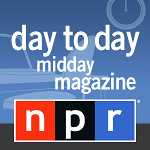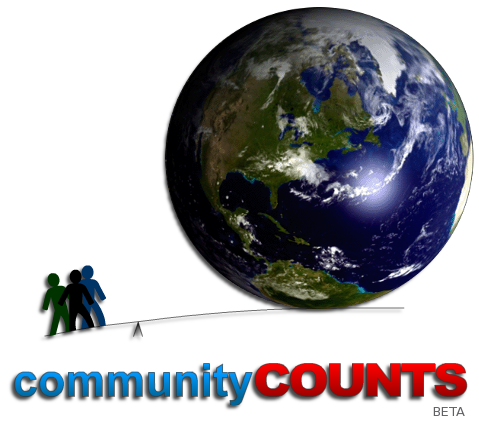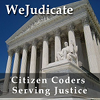 Click on the image above to hear my interview on Day to Day discussing the first iteration of CommunityCounts.
Click on the image above to hear my interview on Day to Day discussing the first iteration of CommunityCounts.

The communityCOUNTS logo. It's meant to show how a few people can "move/change the world."
Shortly after launch, YouTube and CNN announced their plans for a Democratic debate, and once it became clear they didn’t intend to solicit viewer feedback on what questions to ask, re-purposing communityCOUNTS to vote on debate questions seemed a natural next step. This garnered a good amount of press attention, my favorite being an interview on NPR’s Day to Day.
The debate came and went, and still many in the online community felt there was more to do. Post-debate, I began talking with the people over at techPresident about what an ideal online forum would look like for the ‘08 presidential candidates. We wanted to know how best to use the web to improve the discourse. The result was 10questions, a co-creation of Andrew Rasiej, Micah Sifry and myself. The idea was simple. Let the people not only submit questions but also decide what questions should be asked. Don’t constrain responses with artificial time limits, and let the questioners weigh in on whether or not they got a true answer.
Parallel to this, the Republican debate started to look as if it might not happen due to a lack of candidate participation, and we put out a video urging the candidates to commit. Again, it featured myself, Kotecki (EmergencyCheese), Bernstein (Razela), and Brady (faintstarlite). However, it also included appearances from Tony (thewinekone), Highsmith (shelbinatorTV), and Alan (fallofautumndistro).
The great people over at techPresident, including Josh Levy and Anthony Russomano, pulled together a tremendous coalition of bloggers and e-communities to help launch 10questions. Over 40 sites both on the left and right of political webdom joined together to promote the idea that we the people should have a chance to ask the questions. We also partnered with The New York Times Editorial Board and MSNBC in approaching the candidates. Joanne Colan and the Rocktboom crew lent their talents in putting together a few videos, and we hit the ground running in mid October 2007.
We hadn’t counted on Iowa and New Hampshire choosing their candidates so early, and consequently ended up competing for voter and candidate attention in a crowded field. However, the questions submitted for the forum received a respectable 121,614 votes, and in the end, we got the participation of then top tier candidates including Mike Huckabee, John Edwards, and Barack Obama. The format worked, generating real answers from the candidates, and we began thinking about the future.
I tried briefly to build communityCOUNTS into a turnkey platform to spark, collect, rank, and compel discussion around an assortment of web-content from Flickr to YouTube, but it never got much traction. I ran a few independent political forums, and I attempted to make a "viral" video. In the end, however, as one person, I couldn't give it the time it deserved. So I signed over ownership of the codebase to Anaces where it was adapted to run the second iteration of 10questions.
A selection of media coverage surrounding communityCOUNTS can be found here.
Helping provide "justice for all" by building a suite of open source-open API tools for the courts and legal practitioners.
A free on-line curriculum aid allowing teachers & students to create and observe their own solar system.
Answers to science questions, brief lessons, and ideas for teachers and students.

